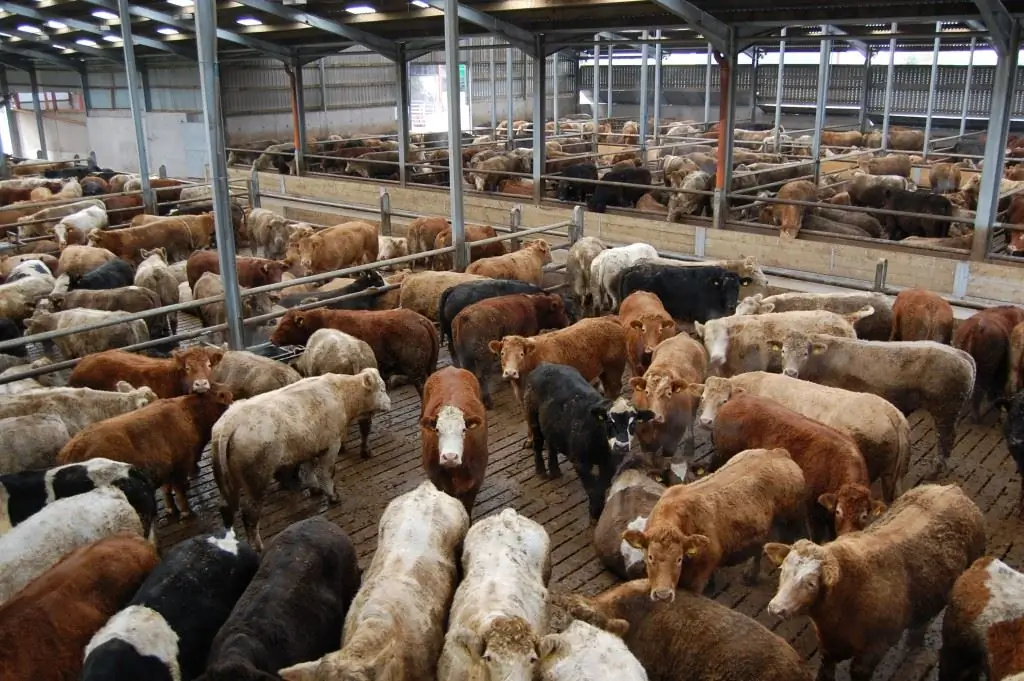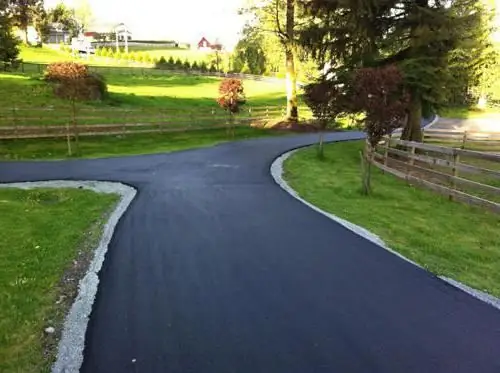2026 Author: Howard Calhoun | [email protected]. Last modified: 2025-01-24 13:10:33
Smooth high-quality road surfaces that provide full grip of the wheels of the vehicle with the canvas are the key to safe and quiet traffic. Due to the active use of the road, it is constantly in need of repair and renewal.
Currently, patching is the most popular type of road repair. This method is used more often than others, because it is much more profitable, more economical and faster. However, there are many complaints about it from car drivers who swear about the quality of road surfaces and the rapid destruction of patches after repairs. But here the reason may not lie in the technology itself, but in those who use it. The quality of such repairs depends on compliance with the patching technology. Quite often, negligent workers do not even pay attention to the conditions and requirements that must be observed in the process of road repair, so an unscrupulous and careless attitude to work more often causes the destruction of road surfaces.

Benefits
Patching the road does not implyperforming any work on the restoration of communications, landscaping: asph alt is laid only in areas that need urgent repairs. In addition, it should be noted that such work must be carried out in strict observance of all points of the technological process. This guarantees cost savings, long service life and maximum quality. Patching allows you to restore the continuity, strength, evenness, adhesion and water resistance of coatings. In addition, it ensures the standard service life of the sections.

Patching has been relevant for decades. There are dozens of technologies for carrying out such repairs of road surfaces, while the optimal method is selected based on weather conditions, the condition of the roadway, the possibilities for the full use of special equipment and the specifics of the materials used. Pothole repair of the road surface has several undeniable advantages:
- no need for total freeway/highway closure;
- promptly carry out all the necessary work (small areas are restored within a day);
- no need to involve heavy special equipment;
- Patching asph alt pavement does not require huge financial costs (compared to major repairs).

The key to success
Usually unscrupulous workers only repair the top layer of damaged areas. However, in realitypatching technology involves the restoration of the underlying layer.
Before starting work, the boundaries of damage are determined, existing defects are identified, potential defects are determined, the scale of work and indicators of reliability, uniformity, strength and roughness of coatings are calculated.
Asph alt rolling
Many domestic enterprises that repair and build roads have rollers weighing 8 tons or more. Such road equipment is justified for full-scale work, but it is not advisable to use it for patching. To compact several tens of meters of the road, it is better to use the “trampling” method, which is implemented using manual vibrating plates. Asph alt patching is also carried out using small pavement or vibratory rollers.

Traditional method
With this method of repair, the damaged area is first separated from the coating, this is done with the help of a road milling machine. Then the edges of the potholes are cut off, giving them rectangular outlines. Then the defective sector is cleaned from dust and crumbs; its edges and bottom are treated with liquid bitumen emulsion or heated bitumen, after which the asph alt concrete mixture is poured.
Patching of the road surface, the technology of which is traditional, allows you to get a high-quality result of work, but it requires a significant number of operations. It is used in the process of repairing various types of coatings from bituminous and mineralasph alt concrete materials.
Repair with heated coatings and reuse of its material
Such patching of the road is based on the use of special equipment for heating the pavement - an asph alt heater. This method allows you to get a high-quality result, save on materials, and facilitate the technology of work. But at the same time, patching of asph alt concrete pavement has significant limitations due to weather conditions (air temperature and wind). This method is used in the process of repairing various types of coatings from bitumen-mineral and asph alt concrete mixtures.
Repair without cutting or heating the old coating
Destruction and deformation of road surfaces are filled with cold polymer-asph alt concrete mixture, wet organo-mineral mixture, cold asph alt concrete, etc. coating durability. This method is used in the process of repairing road surfaces with low traffic intensity, temporary, and also as an emergency measure on roads with high intensity.
Cold patching techniques
This is a patching of pavement, the technology of which is based on the use of cold asph alt concrete or bitumen-mineral mixtures as a repair material. These methods are mainly used in the process of repairing cold asph alt concrete and black gravel on roads of a low category and, if necessary, temporaryor urgent repair of potholes.
Work begins in the spring at an air temperature of at least +10 degrees. At the repair site, the coating is formed under the action of moving vehicles for 20-40 days, and its quality depends on the properties of the bitumen emulsion or liquid bitumen, mineral powder, composition and traffic intensity, weather.
Repairs are possible even at low temperatures, while repair materials are prepared in advance. The cost of repairs using this technology is less than with the hot method. The main disadvantage is the short service life of coatings on roads with the movement of buses and heavy trucks.
Hot Ways
Based on the use of hot mix asph alt as materials: cast asph alt concrete, coarse and fine-grained, sandy, etc.
Methods are used in the repair of roads with asph alt concrete pavement. It is possible to perform work at air temperatures of at least +10 degrees with a dry coating and a thawed base. When using a heater, repair is allowed at a temperature of at least +5 degrees.
Hot processes ensure higher quality and longer life of coatings.

Preparatory operations
Before work, preparatory operations are performed:
- Fencing places, road signs and lighting devices are installed when working at night.
- The places (maps) of repair are marked with chalk or a stretched cord. The repair map is outlined with straight lines perpendicular and parallel to the axis of the road, shaping the outline and capturing the intact pavement.
- Damaged coatings are cut, broken or milled, the removed material is removed. It is carried out for the thickness of the destroyed layer of coatings, but not less than 4 centimeters along the entire length of the repair. When the pothole affects the bottom layer, it is loosened and removed to its full thickness.
- The potholes are cleaned from the remnants of material, dirt and dust.
- Walls and bottom are dried during hot repairs.
- Walls and bottom are treated with bitumen or bitumen emulsion.
Basic operations
Only after preparation can the potholes be filled with repair material. The laying technique and the sequence of procedures depend on the volume and method of work, the type of repair material.
In case of small volumes and the absence of mechanized means, stacking can be done manually. Laying the mixture is carried out in a card in 1 layer when cutting down to a depth of 50 millimeters and in 2 layers at a depth of more than 50 millimeters. At the same time, a coarse-grained mixture of crushed stone can be laid in the lower layer, and a fine-grained mixture in the upper one.
In mechanized laying, the mixture is supplied from a thermos hopper.
When sealing cards 10-20 sq. m asph alt mixes are laid by an asph alt paver. In this case, laying is carried out in a pothole, and the mixture is evenly leveled over the entire area.
Consolidation of the asph alt concrete mixture in the lower layer of the coating is carried out by pneumatic rammers, manualvibratory rollers or electric rammers in the direction from the edges to the middle.
Top layer mix and 1-layer mix at a depth of up to 50 millimeters is compacted by self-propelled vibratory rollers or light type smooth-roller static rollers, and then by heavy-duty rollers.
For low gravel and sandy mixtures, the compaction coefficient should be at least 0.98, for many and medium gravel - 0.99.
Hot mixes are compacted at maximum temperatures at which deformation during rolling is impossible.
Joints that protrude above the surface of the coating are removed by grinding or milling machines.

Final Operations
Final operations involve measures to bring the road surface ready for the movement of vehicles. Workers remove the remaining waste, garbage, immerse them in dump trucks. Also at this stage, road signs and fences are removed, the marking line is restored at the patching site.

Important Requirements
The quality and service life of repaired coatings primarily depend on compliance with the requirements:
- patching is carried out at air temperatures not less than those allowed for a certain repair material on a clean and dry surface;
- in the process of cutting down the old pavement, weakened material is removed from all areas of the pothole where there are breaks, cracks and chipping;
- needs cleansingand drying the repair card;
- necessary to make the correct form of the card, sheer walls, flat bottom;
- be sure to treat all surfaces of the pothole with a binder;
- The repair material is laid at the optimum temperature for this type of mix;
- layer should have a thickness slightly greater than the depth of the pothole, taking into account the margin for compaction factor;
- it is unacceptable to form a layer of new materials on old pavements near the edge of the map to avoid jolts when vehicles run over and quickly destroy sections;
- repair material is well leveled and compacted flush with the road surface.
Quality control
Asph alt concrete polymerization takes place at temperatures above 100 degrees and under high pressure. After compaction of the mixture, the asph alt is not afraid of water. On the contrary, it is desirable to water the restored roadbeds with water to quickly cool and restore traffic.
It should be noted that in case of incomplete compliance with the technology and violation of some rules, asph alt concrete patches made can last at least 2 years. With strict observance of the repair technique - at least 5 years.
The carriageway of the road must comply (after patching has been carried out) with GOST R 50597-93 - "Motor roads and streets".
Recommended:
Keeping bees in multi-hull hives: technology and methods

Hives of this design fully meet the modern requirements of beekeeping. The multi-hull variety has gained wide popularity in countries such as America, Russia, Canada and Australia. This is due to the convenience of this design. Keeping bees in multi-hull hives simplifies the work and facilitates the work of the beekeeper several times
Sheep shearing: technology, methods of shearing, tips and tricks

A herd of sheep has always accompanied man. History does not know a civilization that could do without this animal. Useful meat is obtained from a sheep, its milk is used, and sheep's wool is used to make clothes and many household items. Since the beginning of the 21st century, sheep breeding has become a popular pastime again. People began to return to the earth, to remember many forgotten crafts. They are learning the art of shearing sheep again. Farming revived
Slaughter of cattle at meat processing plants: rules, technology, methods and methods

Providing the consumer basket with meat products directly depends on the slaughter and processing of cattle. Delicious beef and veal dishes are largely the merit of livestock breeders who know how to properly slaughter bulls and cows. There are various technologies, methods and methods for slaughtering cattle, which make it possible to obtain high quality meat products
Asph alt concrete pavement: technology and instructions

The road, made on the basis of asph alt concrete mixture, is considered one of the most profitable pavements. It is practical, inexpensive and generally allows you to provide the characteristics necessary for operation
Resource-saving technology. Industrial technologies. The latest technology

Modern industry is developing very dynamically. In contrast to past years, this development is proceeding intensively, with the involvement of the latest scientific developments. Resource-saving technology is of great importance. This term refers to a whole system of measures aimed at a significant reduction in resource consumption, while maintaining a high level of product quality. Ideally, they try to achieve the lowest possible level of consumption of raw materials

